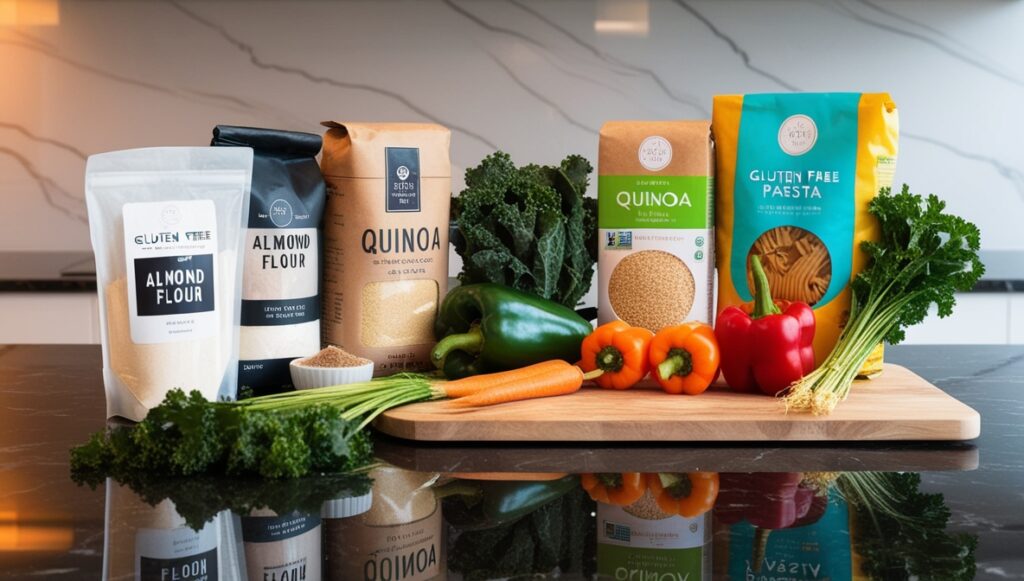Raising a child with celiac disease is a journey that demands resilience, creativity, and unwavering support. Celiac disease, an autoimmune condition triggered by gluten, affects 1 in 100 children globally, requiring strict adherence to a gluten-free diet to prevent intestinal damage and long-term health complications. For parents and caregivers, this diagnosis can feel daunting—balancing daily logistics like gluten-free meal prep and cross-contamination risks with the emotional toll of helping a child feel “normal” in a world filled with gluten.
This comprehensive guide offers evidence-based strategies, real-life success stories, and practical tools to simplify your journey. From mastering school lunches to fostering emotional resilience, we’ll cover every aspect of raising a gluten-free child. Let’s transform challenges into opportunities for growth and connection.

1. Understanding Celiac Disease – A Foundation for Success
Covers the basics of celiac disease, including its autoimmune nature, common symptoms in children, and why strict gluten avoidance is non-negotiable. Prepares parents to make informed decisions
What Every Parent Needs to Know About Gluten and Autoimmunity
Before diving into practical tips, it’s critical to understand celiac disease’s medical and emotional impact.
The Science Simplified
Autoimmune Reaction: When gluten (a protein in wheat, barley, and rye) is ingested, the immune system attacks the small intestine, damaging villi responsible for nutrient absorption.
- Common Symptoms in Children: Chronic diarrhea, fatigue, bloating, irritability, and stunted growth.
- Diagnosis: Blood tests (tTG-IgA) and endoscopic biopsy confirm the condition.
Why Strict Adherence Matters
Even tiny amounts of gluten (1/100th of a breadcrumb) can trigger symptoms and long-term complications like osteoporosis or anemia.
Action Step: Educate family members to build a supportive network.
2. Mastering Gluten-Free School Lunches: Safety, Nutrition, and Fun
From Kitchen to Classroom: A Step-by-Step Plan for Stress-Free Meals
School lunches are a minefield for cross-contamination. Here’s how to ensure safety without sacrificing variety.
Step 1: Partner with the School
- Meet the Staff: Arrange a meeting with teachers, nurses, and cafeteria managers to discuss celiac disease. Provide them with an informative fact sheet to raise awareness.
- Create a 504 Plan or similar Model: Ensure legal accommodations are in place, such as access to gluten-free meal options or the ability to carry gluten-free snacks.
Step 2: Lunchbox Essentials
- Dedicated Tools: Use separate containers, thermoses, and lunchboxes labeled with your child’s name.
- Gluten-Free Staples:
- Proteins: Turkey roll-ups, hard-boiled eggs, chickpea salads.
- Carbs: Quinoa, gluten-free pasta, rice cakes.
- Treats: Enjoy Life cookies, homemade trail mix.
Tip: Teach your child to read ingredient labels to identify hidden sources of gluten.

Step 3: Beat Boredom with Rotating Menus
Sample Weekly Plan:
- Monday: GF chicken nuggets + sweet potato fries.
- Tuesday: Turkey-and-cheese pinwheels with GF tortillas.
- Wednesday: Lentil soup in a thermos + GF crackers.
- Thursday: Gluten-free pasta with marinara sauce + steamed veggies.
- Friday: Build-your-own GF taco salad.
Pro Tip: Batch-cook gluten-free staples (soups, casseroles) on weekends to save time.
Step 4: Score Nutritional Goals
To combat potential nutrient deficiencies, focus on unprocessed, whole foods like:
- Fresh fruits and vegetables
- Lean proteins (chicken, fish, beans)
- Whole grains (quinoa, brown rice)
3. Navigating Social Events: Ensuring Inclusion and Safety
From Birthday Parties to Sleepovers: A Parent’s Playbook for Joyful Participation
Social isolation is a common fear for gluten-free kids. Use these strategies to help them thrive.
Pre-Event Preparation
- Communicate Early: Contact the host 1–2 weeks before the event. Offer to bring a gluten-free dish that serves everyone (e.g., a festive dessert).
- Pack a “Safe Snack Kit”: Include pre-packaged gluten-free treats (e.g., Made Good granola bars) and disposable utensils.

Handling Restaurants and Travel
- Research Ahead: Use apps like Find Me Gluten Free to locate celiac-safe restaurants.
- Cheat Sheet for Staff: Provide a chef card detailing cross-contamination risks (e.g., shared fryers).
Emotional Tip: Role-play scenarios with your child, like politely declining unsafe foods. Praise their courage afterward!
4. Emotional Support: Building Confidence and Resilience
Helping Your Child Thrive Mentally and Emotionally
Celiac disease can trigger anxiety, frustration, or embarrassment. Address these feelings head-on.
Open Dialogue Strategies
- Age-Appropriate Conversations:
- Ages 3–6: Use storybooks like Eating Gluten-Free with Emily.
- Ages 7–12: Explain how gluten harms their body using simple analogies (e.g., “Gluten is like poison for your tummy”).
- Teens: Encourage self-advocacy with scripts like, “I have celiac disease—can I check the ingredient list?”

Building a Support System
- Local Groups: Reach out to local support groups to connect with other parents raising children with celiac disease. They can offer advice, resources, and a sense of community.
- Online Communities: Join online communities or forums for ongoing support and ideas for managing celiac disease in everyday life.
- Therapy Options: Consider play therapy for younger kids or counseling for teens struggling with social anxiety.
Power Phrase: “Having celiac disease makes you strong—you’re learning to take care of yourself in ways others don’t.”
5. Creating a Gluten-Free Home: Practical Daily Strategies
Safe Spaces, Smart Shopping, and Kitchen Hacks for Busy Families
A gluten-free home minimizes risks and reduces daily stress. Either organize the kitchen to ensure safety and efficiency while maintaining a gluten-free environment.
Kitchen Overhaul
- Create a Gluten-Free Zone: Use colored tape to clearly label shelves, cupboards, drawers and containers designated for gluten-free foods and utensils
- Organize the Pantry: Mark all containers and storage items that contain gluten to avoid accidental mix-ups. Proper labeling can save you time and hassle.
- Separate Cooking Utensils: Invest in gluten-free cooking essentials like a separate toaster, colander, cutting boards and mixing bowls to avoid cross-contamination. Using a color-coded system for utensils and cookware is a great way to stay organized and ensure gluten-free safety.
- Cleaning Protocol: Develop a cleaning routine to avoid cross-contamination. Wipe down all surfaces before and after preparing gluten-free foods, and wash your hands frequently while cooking.

Grocery Shopping Made Simple
- Gluten-Free Safe Brands: Choose Certified Gluten-Free Products for Peace of Mind
- Label-Reading Cheat Sheet: Avoid malt, soy sauce, and modified food starch unless labeled GF.
Pro Tip: Involve your child in grocery shopping and cooking. Let them pick a new gluten-free product to try each week!
6. Collaborating with Healthcare Providers
Teamwork for Optimal Health: Dietitians, Doctors, and Beyond
Regular medical support ensures your child’s physical and emotional needs are met.
Must-Ask Questions from Specialists
- “Are my child’s nutrient levels (iron, vitamin D) optimal?”
- “What vaccines are recommended for celiac patients?”

Monitoring Growth and Development
- Track height/weight percentiles annually.
- Address delayed puberty or dental issues linked to malabsorption.
7. Real-Life Success Stories: Inspiration from Families Like Yours
This section is designed to humanize the journey of raising a child with celiac disease by showcasing real-world examples of resilience and creativity. It includes:
- Case Study 1: A 10-year-old who channeled their frustration into a gluten-free baking blog, connecting with peers globally and turning a dietary restriction into a passion project.
- Case Study 2: A parent who collaborated with their school to create a shared gluten-free snack pantry, fostering inclusivity and reducing stigma.
Why This Matters?
- Relatability: Parents see they’re not alone in their struggles.
- Practical Inspiration: Offers actionable ideas (e.g., starting a blog, advocating for school changes) that readers can adapt.
- Emotional Uplift: Stories of resilience and creativity remind families that challenges can lead to growth.

8. Conclusion: Empowering Your Family to Thrive
Raising a child with celiac disease comes with its challenges, but it can also be incredibly rewarding. By focusing on safety, fostering open communication, and building a strong sense of community, you can empower your child to grow into a confident, health-conscious individual. Each gluten-free meal and meaningful conversation strengthens their ability to navigate the world with resilience and independence.
Educate family members and involve your child in meal planning and preparation to create a supportive network while boosting their self-esteem. These expert-backed strategies make managing celiac disease more manageable and less daunting.
Celiac disease doesn’t need to limit your child’s happiness or health. With the right knowledge and preparation, gluten-free living can be a positive, fulfilling experience for the entire family. Embrace the journey, and show your child that they can thrive—gluten-free and beyond.


